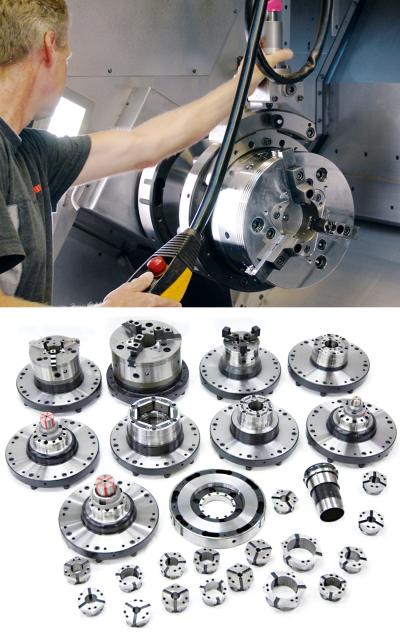
The centroteX System from HAINBUCH America offers significant advantages to manufacturers processing multiple parts of varying sizes requiring various clamping methods.
According to Dale Sonnenburg, HAINBUCH America engineering manager: “HAINBUCH’s reputation for precision workholding is built around versatile high-precision chucks designed for the fast change of collets, bushings, jaws, and other clamping devices. The centroteX System takes this even further by facilitating the fast and easy changeover of the entire chuck. This not only increases the range of part diameters that can be machined, but extends the capability of the machine tool in terms of process variability. Further, it allows for workholding devices to be quickly and accurately mounted on multiple milling and turning machines within a manufacturing plant”
At the heart of the system is a precision-machined adaptor/flange plate aligned with centrex interface, equipped with a bayonet mount and a drawtube adapter. This in turn accommodates an extensive variety of chucks and holding devices that are easily connected and locked by six simple fasteners. Changeover time of the centroteX system is typically less than 6 minutes, while maintaining repeatability and changeover accuracy of less than 0.002mm.
A second element of the system is the Monteq mounting aid for large and heavy clamping devices. Used with a suspension bar on a lathe or an overhead crane, the Monteq offers improved balance and ease of component handling during changeover. Gradations on the device assist in the simple alignment of the horizontal axis, and non-threaded, quick-action bolts secure the workholding device for loading or removal.
A third element of the system is the clamping device container. Customized to hold chucks or other equipment when not in use, the ruggedly built unit moves on heavy-duty casters and features a retractable hood to shut out contaminants and maintain the integrity of the stored components.
In a current application, a centroteX customer utilizes nine different clamping devices allowing them to clamp O.D.'s ranging from 5mm to 265mm, and in IDs up to 160mm. All can be accomplished with one simple changeover taking less than 6 minutes.
Dale Sonnenburg states, “As important as setup time and extended machine utilization are, the advantage of centroteX is the ability to achieve both in the context of precision workholding.”
Contact Details
Related Glossary Terms
- chuck
chuck
Workholding device that affixes to a mill, lathe or drill-press spindle. It holds a tool or workpiece by one end, allowing it to be rotated. May also be fitted to the machine table to hold a workpiece. Two or more adjustable jaws actually hold the tool or part. May be actuated manually, pneumatically, hydraulically or electrically. See collet.
- gang cutting ( milling)
gang cutting ( milling)
Machining with several cutters mounted on a single arbor, generally for simultaneous cutting.
- lathe
lathe
Turning machine capable of sawing, milling, grinding, gear-cutting, drilling, reaming, boring, threading, facing, chamfering, grooving, knurling, spinning, parting, necking, taper-cutting, and cam- and eccentric-cutting, as well as step- and straight-turning. Comes in a variety of forms, ranging from manual to semiautomatic to fully automatic, with major types being engine lathes, turning and contouring lathes, turret lathes and numerical-control lathes. The engine lathe consists of a headstock and spindle, tailstock, bed, carriage (complete with apron) and cross slides. Features include gear- (speed) and feed-selector levers, toolpost, compound rest, lead screw and reversing lead screw, threading dial and rapid-traverse lever. Special lathe types include through-the-spindle, camshaft and crankshaft, brake drum and rotor, spinning and gun-barrel machines. Toolroom and bench lathes are used for precision work; the former for tool-and-die work and similar tasks, the latter for small workpieces (instruments, watches), normally without a power feed. Models are typically designated according to their “swing,” or the largest-diameter workpiece that can be rotated; bed length, or the distance between centers; and horsepower generated. See turning machine.
- milling
milling
Machining operation in which metal or other material is removed by applying power to a rotating cutter. In vertical milling, the cutting tool is mounted vertically on the spindle. In horizontal milling, the cutting tool is mounted horizontally, either directly on the spindle or on an arbor. Horizontal milling is further broken down into conventional milling, where the cutter rotates opposite the direction of feed, or “up” into the workpiece; and climb milling, where the cutter rotates in the direction of feed, or “down” into the workpiece. Milling operations include plane or surface milling, endmilling, facemilling, angle milling, form milling and profiling.
- turning
turning
Workpiece is held in a chuck, mounted on a face plate or secured between centers and rotated while a cutting tool, normally a single-point tool, is fed into it along its periphery or across its end or face. Takes the form of straight turning (cutting along the periphery of the workpiece); taper turning (creating a taper); step turning (turning different-size diameters on the same work); chamfering (beveling an edge or shoulder); facing (cutting on an end); turning threads (usually external but can be internal); roughing (high-volume metal removal); and finishing (final light cuts). Performed on lathes, turning centers, chucking machines, automatic screw machines and similar machines.






